Related Research Articles
Æthelweard was an ealdorman and the author of a Latin version of the Anglo-Saxon Chronicle known as the Chronicon Æthelweardi. He was a kinsman of the royal family, being a descendant of the Anglo-Saxon King Æthelred I of Wessex, the elder brother of Alfred the Great.

Wulfstan was an English Benedictine monk who served as Bishop of Worcester from 1062 to 1095. He was the last surviving pre-Conquest bishop. Wulfstan is a saint in the Western Christian churches.
Historians in England during the Middle Ages helped to lay the groundwork for modern historical historiography, providing vital accounts of the early history of England, Wales and Normandy, its cultures, and revelations about the historians themselves.
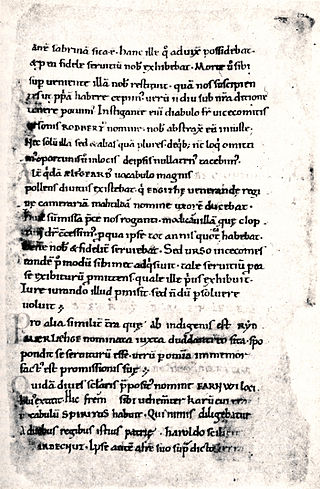
Eadric Streona was Ealdorman of Mercia from 1007 until he was killed by King Cnut. Eadric was given the epithet "Streona" in Hemming's Cartulary because he appropriated church land and funds for himself. Eadric became infamous in the Middle Ages because of his traitorous actions during the Danish re-conquest of England.
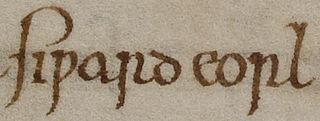
Siward or Sigurd was an important earl of 11th-century northern England. The Old Norse nickname Digri and its Latin translation Grossus are given to him by near-contemporary texts. It is possible Siward may have been of Scandinavian or Anglo-Scandinavian origin, perhaps a relative of Earl Ulf, although this is speculative. He emerged as a regional strongman in England during the reign of Cnut. Cnut was a Scandinavian ruler who conquered most of England in the 1010s, and Siward was one of many Scandinavians who came to England in the aftermath, rising to become sub-ruler of most of northern England. From 1033 at the latest, he was in control of southern Northumbria, present-day Yorkshire, governing as earl on Cnut's behalf.
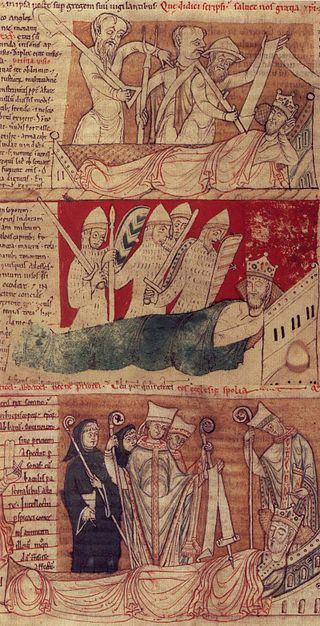
John of Worcester was an English monk and chronicler who worked at Worcester Priory. He is now usually held to be the author of the Chronicon ex Chronicis.
Pehthelm was the first historical bishop of the episcopal see of Candida Casa at Whithorn. He was consecrated in 730 or 731 and served until his demise. His name is also spelled as Pecthelm, Pechthelm, and sometimes as Wehthelm.
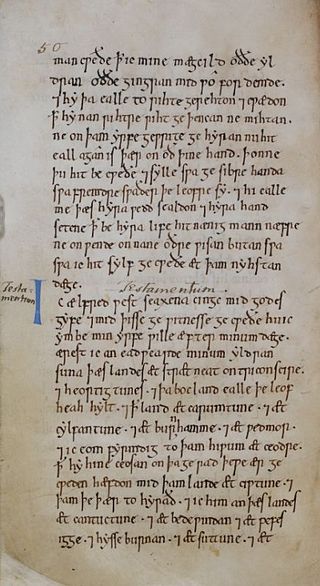
Æthelweard was the younger son of King Alfred the Great and Ealhswith.
Ælfgifu of York was the first wife of Æthelred the Unready, King of the English; as such, she was Queen of the English from their marriage in the 980s until her death in 1002. They had many children together, including Edmund Ironside. It is most probable that Ælfgifu was a daughter of Thored, Earl of southern Northumbria and his wife, Hilda.

The Liber Eliensis is a 12th-century English chronicle and history, written in Latin. Composed in three books, it was written at Ely Abbey on the island of Ely in the fenlands of eastern Cambridgeshire. Ely Abbey became the cathedral of a newly formed bishopric in 1109. Traditionally the author of the anonymous work has been given as Richard or Thomas, two monks at Ely, one of whom, Richard, has been identified with an official of the monastery, but some historians hold that neither Richard nor Thomas was the author.
Urse d'Abetot was a Norman who followed King William I to England, and became Sheriff of Worcestershire and a royal official under him and Kings William II and Henry I. He was a native of Normandy and moved to England shortly after the Norman Conquest of England in 1066, and was appointed sheriff in about 1069. Little is known of his family in Normandy, who were not prominent, but he probably got his name from the village Abetot. Although Urse's lord in Normandy was present at the Battle of Hastings, there is no evidence that Urse took part in the invasion of England in 1066.
Æthelwig was an Abbot of Evesham before and during the Norman Conquest of England. Born sometime around 1010 or 1015, he was elected abbot in 1058. Known for his legal expertise, he administered estates for Ealdred, the Bishop of Worcester prior to his election as abbot. After his election, he appears to have acted as Ealdred's deputy, and was considered as a possible successor when Ealdred was elected Archbishop of York. Æthelwig worked during his abbacy to recover estates that had been lost to Evesham, as well as acquiring more estates.
Hemming was a monk, author and compiler in medieval England from around the time of the Norman conquest of England. He was a senior brother at Worcester Cathedral Priory, and his significance derives from the monastic cartulary attributed to him.

Hemming's Cartulary is a manuscript cartulary, or collection of charters and other land records, collected by a monk named Hemming around the time of the Norman Conquest of England. The manuscript comprises two separate cartularies that were made at different times and later bound together; it is in the British Library as MS Cotton Tiberius A xiii. The first was composed at the end of the 10th or beginning of the 11th century. The second section was compiled by Hemming and was written around the end of the 11th or the beginning of the 12th century. The first section, traditionally titled the Liber Wigorniensis, is a collection of Anglo-Saxon charters and other land records, most of which are organized geographically. The second section, Hemming's Cartulary proper, combines charters and other land records with a narrative of deprivation of property owned by the church of Worcester.
The Historia Ecclesie Abbendonensis or History of the Church of Abingdon was a medieval chronicle written at Abingdon Abbey in England in the 12th century. The Abbey was historically in the county of Berkshire, but since 1974 has been in the county of Oxfordshire.
John of Eversden or Everisden was an English chronicler.

Morville Priory was a small Benedictine monastery in Shropshire, England, a cell of Shrewsbury Abbey.
Reginald Ralph Darlington, FBA, FSA, FRHistS was an English historian.
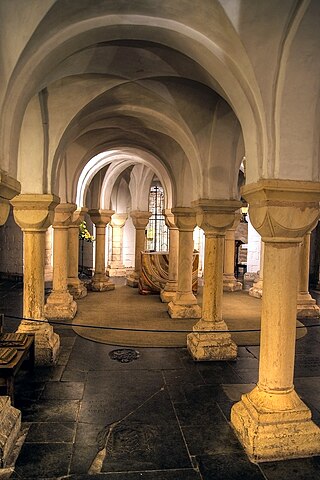
Nicholas of Worcester was prior of the Benedictine priory of Worcester Cathedral from about 1115 until his death. He was born around the time of the Norman Conquest. It is not known who his parents were, but the twelfth-century historian William of Malmesbury wrote that he was "of exalted descent", and the historian Emma Mason argues that he was a son of King Harold Godwinson.
The Bury Chronicle, Bury St Edmunds Chronicle, or Chronicle of Bury St Edmunds is a medieval English chronicle compiled by John of Taxster and two other unknown Benedictine monks of Bury St Edmunds Abbey in the 13th and 14th centuries.
References
Citations
- ↑ Thorpe (1849).
- 1 2 3 4 5 6 7 Keynes, "Florence".
- ↑ Chronicon ex chronicis, entry for 1118, translation by McGurk.
- 1 2 3 4 Gransden, Legends, traditions and history in medieval England, p. 117.
- ↑ For instance, Hodgkin, "The History of England from the Earliest Times to the Norman Conquest", p. 502.
- 1 2 Gransden, Historical Writing, p. 144.
- ↑ Darlington, The Vita Wulfstani of William of Malmesbury, p. xvi-xvii.
- ↑ Higham, "Edward the Elder's Reputation", p. 2
Bibliography
- Darlington, R. R. (1928). The Vita Wulfstani of William of Malmesbury. London.
{{cite book}}: CS1 maint: location missing publisher (link) - Gransden, Antonia (1974). Historical writing in England c. 550 to 1307. Vol. 1. London.
{{cite book}}: CS1 maint: location missing publisher (link) - Gransden, Antonia (1992). Legends, traditions and history in medieval England. London, et al.: Hambledon.
- Higham, Nick (2001). "Edward the Elder's Reputation: An Introduction". In Higham, N. J.; Hill, D. H. (eds.). Edward the Elder, 899–924. London, UK: Routledge. pp. 1–11. ISBN 0-415-21497-1.
- Hodgkin, Thomas (1906). "The History of England from the Earliest Times to the Norman Conquest". In William Hunt and Reginald L. Poole (ed.). The Political History of England. Vol. 1. London: Longmans.
- Keynes, Simon (2001). "Florence". In Michael Lapidge; et al. (eds.). The Blackwell Encyclopaedia of Anglo-Saxon England. Oxford: Blackwell. p. 188.
- McGurk, P., ed. (1998). The Chronicle of John of Worcester, III: Annals from 1067 to 1140. OMT. Oxford: Clarendon.
- Thorpe, Benjamin, ed. (1849), Florentii Wigorniensis Monachi Chronicon ex Chronicis... [The Monk Florence of Worcester's Chronicle from Chronicles...](PDF), Vol. II (in Latin), London: English Historical Society.